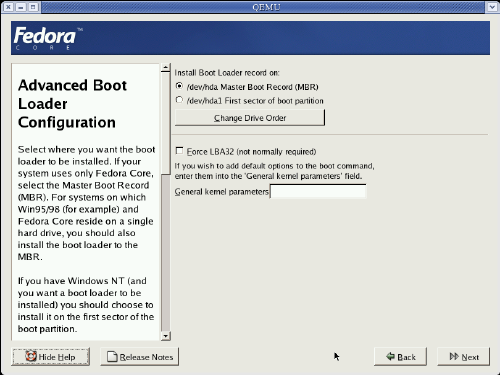The default boot options are adequate for most situations. The installation program writes the GRUB boot loader in the master boot record (MBR), overwriting any existing boot loader.
Tto keep your current boot loader in the MBR, use the advanced settings to place GRUB in the first sector of the partition holding the Linux root file system.
You may also need the advanced options if your BIOS enumerates your disk devices differently than Fedora expects. On a few systems, Fedora may not configure the disk drive geometry for large disks correctly because of a broken BIOS. To work around this problem, mark the Force LBA32 checkbox.
The Linux kernel usually auto-detects its environment correctly, and no additional kernel parameters are needed. You may provide any needed kernel parameter, however, using the advanced boot loader options.
![[Note]](./stylesheet-images/note.png) | Note |
|---|---|
For a partial list of the kernel command line parameters, type the following command in a terminal window: man bootparam. For a comprehensive and authoritative list, refer to the documentation provided in the kernel sources. | |
To alter any of these settings, mark the Configure advanced boot loader options checkbox. Select Next and the menu shown in Figure 7.5, “Advanced Boot Options” appears.
![[Note]](./stylesheet-images/note.png) | Note |
|---|---|
Fedora displays the following advanced boot options menu only if the advanced configuration checkbox described above has been selected. | |
